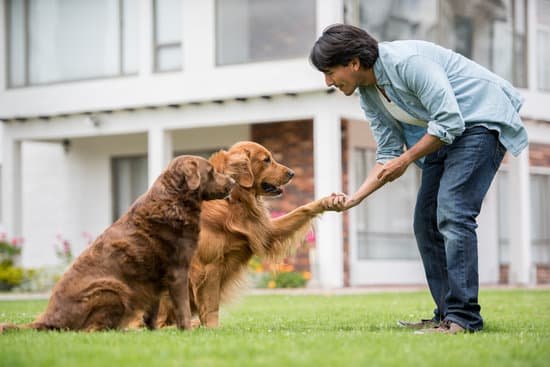Crate training is an essential aspect of raising a well-behaved and happy dog. It provides numerous benefits, from helping with potty training to providing a safe space for the dog to relax. However, one common challenge that many dog owners face during crate training is excessive barking. In this article, we will explore effective strategies to stop your dog from barking while crate training.
Properly crate training your dog is crucial for their overall well-being. It serves as a den-like space where they can feel secure and comfortable. Additionally, crate training helps prevent destructive behaviors when the dog is left unsupervised and aids in managing separation anxiety. By teaching your dog to enjoy spending time in their crate, you are laying the foundation for better behavior and a stronger bond between you and your furry friend.
While implementing crate training, it’s important to keep a few key points in mind. First, always ensure that the crate is the appropriate size for your dog – not too small or too large. Secondly, create an inviting environment inside the crate by adding cozy bedding, toys, and treats. Lastly, remember that consistency and patience are key when introducing the concept of crate training to your canine companion.
Now let’s delve deeper into understanding why dogs bark during crate training and explore effective strategies to address this issue.
Understanding the Root Cause of Barking during Crate Training
When crate training a dog, it is important to understand the root cause of their barking behavior. Dogs may bark when crated due to various reasons, and addressing the underlying cause is crucial in stopping the barking effectively. Some common reasons why dogs bark during crate training include separation anxiety, discomfort, and lack of proper training.
Separation anxiety is one of the primary reasons why dogs bark when crated. They may feel anxious or distressed when left alone in a confined space, leading them to vocalize their distress through barking. It is essential to address separation anxiety before attempting to stop the barking behavior entirely. This can be done through gradual desensitization exercises and teaching the dog to associate positive experiences with being crated.
Discomfort is another factor that can contribute to a dog’s barking while crate training. If the crate is too small or uncomfortable, they may express their discomfort through barking. Choosing the right-sized crate for your dog is important, ensuring that they have enough space to stand up, turn around, and lie down comfortably. Additionally, creating a comfortable environment within the crate by adding bedding, toys, and treats can help make it more inviting and reduce feelings of discomfort.
Lastly, inadequate training or lack of familiarity with being crated can also lead to barking behavior. Dogs need time and patience to become accustomed to being crated. By gradually introducing the crate in a positive manner and associating it with rewards and praise, you can help your dog develop a positive association with being crated.
Understanding these key factors behind a dog’s barking during crate training will help you address the issue effectively. By addressing separation anxiety, ensuring comfort in the crate environment, and implementing proper training techniques, you can work towards eliminating excessive barking while your dog is crated.
| Reasons for Barking during Crate Training | Common Causes |
|---|---|
| Separation Anxiety | Dogs feel anxious when left alone in a confined space |
| Discomfort | Crate is too small or uncomfortable for the dog |
| Lack of Proper Training | Dogs are not familiar with being crated and require gradual introduction |
Set Up the Perfect Crate Environment
One crucial factor in successfully crate training your dog is to ensure that the crate environment is comfortable and inviting. Creating a positive atmosphere in the crate can help reduce barking and make your dog more willing to spend time inside it. Here are some tips for setting up the perfect crate environment:
- Choose the right-sized crate: It’s important to select a crate that is appropriate for your dog’s size. The crate should be just big enough for your dog to stand, turn around, and lie down comfortably. A crate that is too large may encourage your dog to use one portion of it as a bathroom area.
- Make it cozy: Adding bedding to the crate can make it more comfortable for your dog. Choose bedding that is washable and suitable for your dog’s needs, such as a soft blanket or a pet bed with cushioning. Avoid using materials that can be easily shredded or swallowed.
- Add toys and treats: Providing toys and treats in the crate can help make it a more appealing place for your dog. Interactive puzzle toys or stuffed Kong toys filled with treats can keep them entertained while in the crate. Be sure to choose safe and durable toys that cannot be easily destroyed.
- Location matters: Find a suitable location in your home for the crate, preferably in an area where your family spends most of its time. This will make your dog feel like part of the pack even when they are crated. Avoid placing the crate in isolated areas or places with excessive noise or drafts.
Creating an inviting environment in the crate will help your dog associate it with positive experiences, making them more likely to voluntarily enter and stay quiet while inside it.
| Tips | Explanation |
|---|---|
| Choose the right-sized crate | Selecting a properly sized crate is essential for your dog’s comfort and safety. |
| Make it cozy | Adding bedding can make the crate a comfortable and inviting space for your dog. |
| Add toys and treats | Providing toys and treats can make the crate more appealing and entertaining for your dog. |
| Location matters | Finding the right location in your home for the crate can help your dog feel like part of the family. |
Gradual and Positive Crate Introduction
To ensure a successful crate training experience and prevent excessive barking, it is crucial to introduce the crate to your dog in a gradual and positive manner. Rushing the process can lead to anxiety and resistance from your dog, resulting in increased barking. Follow these steps for a smooth and positive crate introduction:
- Start Slow: The first step is to allow your dog to explore the crate at their own pace. Leave the door open and let them approach it voluntarily without any pressure. Encourage them with praise or treats when they show interest or go near the crate.
- Create Positive Associations: Make the crate an appealing place for your dog by adding their favorite bedding, toys, and treats inside. This will help create positive associations with the space and make it more inviting.
- Mealtime in the Crate: Begin feeding your dog their meals near or even inside the crate. Gradually move their food bowl closer to the entrance until they are comfortable eating inside the crate. This will help them associate positive experiences with being in the crate.
- Short Incremental Sessions: Once your dog is comfortable entering the crate for meals, start closing the door for short periods while they eat or enjoy their favorite chew toy. Initially, keep these sessions brief (a few minutes) and gradually increase the duration over time.
- 5.Provide Positive Reinforcement: Whenever you open the door after a successful session, reward your dog with praise or treats to reinforce their positive behavior.
- 6.Consistency: Consistency is key during this process. Stick to a regular schedule of short sessions throughout the day, gradually building up longer periods of time spent in the crate.
Remember to be patient and understanding during this phase of crate training as some dogs may take longer than others to feel comfortable being confined. Each dog is unique, so adjust these steps based on your pet’s progress. By approaching crate introduction positively and gradually, you can minimize barking and ensure a comfortable crate training experience for your canine companion.
Establishing a Consistent Crate Training Routine
Establishing a consistent crate training routine is crucial for successfully stopping a dog from barking while being crate trained. Dogs thrive on structure and routine, and by implementing a consistent schedule, you can help your furry friend adjust to the crate more easily and minimize their barking behavior. In this section, we will discuss how to create a structured crate training routine, the importance of regular feeding and exercise schedules, and tips for gradually increasing crate time.
Creating a structured crate training schedule is essential in helping your dog understand that the crate is a safe and positive space. Start by determining specific times for feeding, exercise, playtime, and potty breaks. Consistency in these activities will not only promote overall well-being but also help your dog establish a predictable routine.
During the initial stages of crate training, it is recommended to associate positive experiences with the crate to encourage your dog’s acceptance. Begin by introducing short periods of crate time after meals or during calm periods when your dog is tired. Gradually increase the duration over time as your pup becomes more comfortable.
Regular feeding routines play an integral role in establishing a successful crate training routine. It’s important to feed your dog his meals inside the crate while keeping the door open initially. This helps create positive associations with being in the confined space and rewards them for staying calm while eating.
In addition to regular feeding schedules, maintaining consistent exercise routines is equally important for effective crate training. Ensure that your furry companion receives ample physical activity before placing them inside the crate. A tired dog is more likely to be relaxed and less prone to excessive barking.
As you progress with your consistent routine, gradually increase the duration of time spent in the crate while providing intermittent breaks for exercise or potty breaks outside. This gradual build-up helps prevent feelings of confinement or frustration that may trigger excessive barking.
Remember that patience and consistency are key during this process. Each individual dog may respond differently to crate training, so it’s important to tailor the routine according to your pet’s needs. Your dedication and commitment will ultimately result in a well-behaved and content canine companion.
By establishing a consistent crate training routine that includes regular feeding, exercise, and gradual increases in crate time, you can effectively stop your dog from barking while being crate trained. Remember to be patient, as each dog may require different amounts of time to adjust. In the next section, we will explore how to address separation anxiety through desensitization exercises during crate training.
Addressing Separation Anxiety and Desensitization Exercises
Separation anxiety is a common issue that can cause dogs to bark excessively during crate training. It is important to address this underlying issue in order to effectively stop the barking. Recognizing the signs of separation anxiety is the first step in addressing this issue. Signs may include excessive barking or whining, destructive behavior, attempts to escape from the crate, and urinating or defecating in the crate.
Desensitization exercises can be helpful in addressing separation anxiety and reducing barking. These exercises involve gradually increasing the dog’s tolerance to being separated from their owner by starting with short periods of time and gradually extending them. The goal is to show the dog that being alone does not always result in negative outcomes.
To start desensitization exercises, begin by leaving your dog in their crate for a very short period of time while you are still at home. Gradually increase the duration as your dog becomes more comfortable and shows signs of relaxation. Reward calm behavior with treats or praise.
It is important to remain patient and consistent throughout this process. Rushing or pushing your dog too quickly could worsen their anxiety and lead to more excessive barking. Each dog will progress at their own pace, so it is important to monitor their response and adjust accordingly.
By addressing separation anxiety through desensitization exercises, you can help your dog feel more secure during crate training and reduce excessive barking. Remember to reward calm behavior and seek professional help if necessary if the barking persists or worsens despite your efforts.
Corrective Techniques
One effective way to stop a dog from barking during crate training is by teaching them the “quiet” command. This command can help to redirect their barking behavior and promote calmness in the crate. By following a step-by-step process and using positive reinforcement, you can successfully teach your dog to be quiet on command.
Introducing the “Quiet” Command
To start, choose a verbal cue such as “quiet” or “enough” that you will consistently use when teaching your dog to be quiet. It’s important to select a word that is easy for you to remember and pronounce clearly.
Next, find a quiet environment where you can work with your dog without distractions. Begin by letting your dog bark naturally. Once they have been barking for a few moments, calmly say the chosen cue word (“quiet”) once, with a firm but gentle tone of voice.
If your dog pauses briefly from barking, even for just a second, immediately praise them with enthusiasm and reward them with treats or verbal praise. If they continue barking after you’ve said the cue word, simply ignore their behavior and do not provide any attention or rewards until they pause.
Repeat this process several times until your dog starts associating the cue word with being quiet and receiving positive reinforcement. Over time, they will begin to understand that being quiet when you say the cue word leads to rewards.
Reinforcing the Command during Crate Training Sessions
Once your dog has started responding well to the “quiet” command in general situations, it’s time to reinforce this behavior during crate training sessions. Whenever you are working with your dog in their crate and they start barking, use the que word (“quiet”) in the same manner as before.
Remember to always stay calm and patient during these training sessions. Consistency is key – make sure you give praise and rewards only when your dog is quiet in the crate after hearing the cue word.
With time and practice, your dog will learn to associate the “quiet” command specifically with being calm and quiet while in their crate. This can be a valuable tool to have at your disposal whenever barking becomes an issue during crate training or any other situations.
By incorporating the “quiet” command into your dog’s crate training routine, you can effectively address their barking behavior and create a peaceful environment for both you and your furry friend.
Seeking Professional Help if Necessary
In some cases, despite your best efforts, you may find that your dog’s barking during crate training persists or even worsens. When this happens, it may be time to seek professional help. A certified dog trainer or behaviorist can provide invaluable guidance and support to address the behavioral issue and effectively stop the barking.
Working with a professional can be beneficial for multiple reasons. Firstly, they have the expertise and experience to accurately assess your dog’s behavior and identify the root cause of the barking. They will be able to develop a personalized training plan tailored to your specific situation, taking into account any underlying issues such as separation anxiety or fear.
Additionally, a professional can provide guidance on proper training techniques and help you implement them effectively. They can observe your interactions with your dog and provide real-time feedback and suggestions for improvement. With their guidance, you’ll be able to refine your approach and make necessary adjustments to ensure success.
Finally, seeking professional help shows dedication to your dog’s well-being and training progress. It demonstrates that you are committed to finding an effective solution for the barking issue and are willing to invest time, effort, and resources into achieving positive results.
If you’re in need of professional assistance, there are many resources available. Research local certified dog trainers or behaviorists in your area who specialize in addressing barking issues or crate training. Read reviews or testimonials from past clients to get an idea of their expertise and effectiveness. Don’t hesitate to reach out for consultations or more information before making a decision.
Remember that every dog is unique, so finding the right professional who understands your dog’s specific needs is important. By seeking professional help when needed, you’ll have access to targeted support and guidance that can make all the difference in stopping your dog’s barking during crate training.
Frequently Asked Questions
Should I ignore dog barking in crate?
It is generally not recommended to ignore dog barking in the crate. Dogs bark for various reasons, and when they bark in their crate, it could be a sign that something is amiss.
Ignoring the barking may reinforce this behavior, as the dog might learn that barking leads to attention or release from the crate. Instead of ignoring, it is advisable to understand why your dog is barking and address the underlying cause to find an appropriate solution.
How do I train my dog to be quiet in his crate?
Training a dog to be quiet in their crate requires patience and consistency. Start by ensuring that your dog’s basic needs are met, such as exercise, mental stimulation, and bathroom breaks before crating them. Gradually introduce crate time to your dog using positive reinforcement techniques like treats or praise when they enter the crate willingly.
Practice leaving your dog in the crate for short periods while remaining nearby so you can reward calm behavior and gradually increase crate time duration. Utilize distractions such as toys or interactive puzzles to occupy their attention while they are inside the crate. Gradually wean them off these distractions and continue reinforcing calm behavior until your dog learns to be quiet in their crate.
Why is my crate trained dog barking?
There can be several reasons why a previously crate trained dog starts barking while crated. Some dogs may associate being crated with negative experiences if they have been crated for excessively long periods without enough breaks or if separated from their owners for long durations abruptly. Anxiety or fear might also trigger barking behavior in dogs when confined to a crate, especially if they have not been properly acclimated or have had traumatic past experiences relating to crates or confinement.
Additionally, certain medical conditions like pain or discomfort could also contribute to increased barking in crates as dogs try to communicate their distress. Addressing these issues often involves gradually reintroducing positive experiences with crates, creating a comfortable and safe environment inside the crate, seeking professional help if necessary, and consulting a veterinarian if you suspect an underlying medical cause.

Welcome to the blog! I am a professional dog trainer and have been working with dogs for many years. In this blog, I will be discussing various topics related to dog training, including tips, tricks, and advice. I hope you find this information helpful and informative. Thanks for reading!





